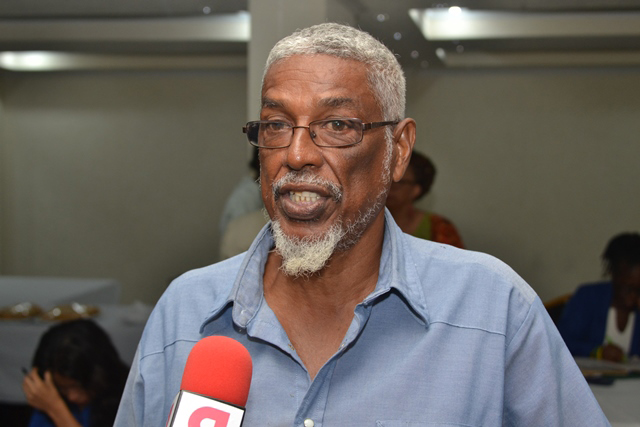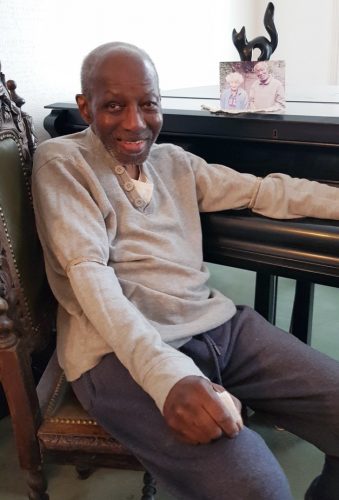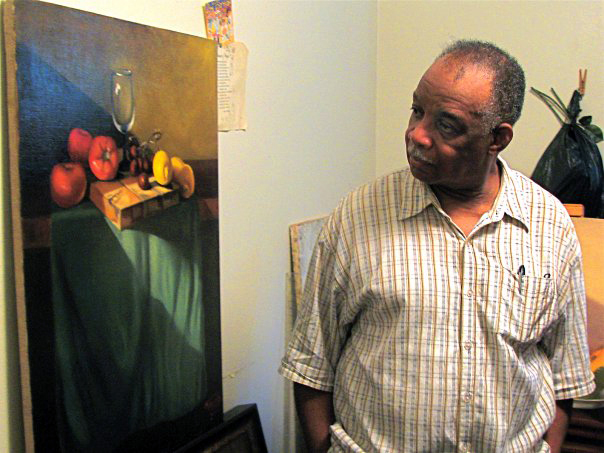Patrick Barrington was one of the early members of the Working Peoples Art Class (WPAC) founded by Edward R. Burrowes in 1948. He was my senior. Barry, as we called him, was a lively character who liked to talk while working, especially during Thursday evening classes in still life compositions. He had a good sense of humour, and the distinctive laughter of a happy person. According to an article in the Guardian newspaper, during childhood his spare time was spent drawing or painting.

Barrington was in his early twenties when told by his parents, who threatened to destroy his work, that he had to stop painting. The WPAC was then located at Smith’s Church School in Hadfield Street near Camp and he was living in the same street near Vlissengen Road. Barrington’s parents truly felt he would not be able to earn a living through art. He appealed to Burrowes, who went to speak with his parents. Burrowes had a commanding presence, which Barrington’s father, who was a policeman, would have recognised. Barrington was allowed to continue. He undoubtedly was quite talented as a painter, something Burrowes had recognised and encouraged.
An exhibition, our first, was planned for 1953, the same year the first national elections were held. Burrowes encouraged members to go sketching outdoors on Sundays to prepare studies for painting later on Saturdays. By now Barrington, well read in Art History, loved landscape painting and greatly admired the work of the famous British landscape painter John Constable whose landscapes, painted outdoors, had a freedom and vitality that appealed to him. For the exhibition, influenced by Constable’s work, Barrington produced a series of well executed paintings done in the Botanic Gardens. Portraiture was also something he loved and Peter Rubens was his favourite painter in this genre. With information learnt from reading, he even went so far as to make ‘Rubens Jelly,’ an oil painting medium from materials bought in pharmacies.

Barrington’s work was a hit at the show and he won a silver medal. Donald Locke, for his paintings and for assisting Burrowes in teaching, won the gold. I received a silver medal for my efforts in different media. Anthony Tasker, the Director of Public Relations for the Booker Group of Companies, was a friend of Burrowes and the WPAC. He admired Barrington’s paintings and was instrumental in getting the Company to offer Barry a fellowship to study painting at the prestigious Byam Shaw School in London, which he did. We all wished him well and felt he would be successful in his studies. It was reported years later that he had graduated and had gone to work at a design studio in Paris.
I was living in Barbados when he returned on a visit to Guyana in the 1990s. Arriving sometime afterwards I was most disappointed at missing the opportunity of seeing him. There was no further news of him until friends informed me of his demise and on reading his obituary, I was very pleased to see that he did continue painting, not daunted by the conditions in ‘the real world of art’. Barrington is represented in the National Collection by work which was in the Colgrain House (Bookers) Collection, initiated by Sir Jock Campbell, head of the Booker Group of Companies in the UK. Sir Jock, on a visit to the home of Basil Hinds, the art critic, had seen works by local artists and was quite impressed.
Maurice Jacobs joined the WPAC a little after Barrington and they became firm friends as they shared interests other than art. Both of them would sometimes demonstrate the very acrobatic jitterbug style of dancing seen in American movies of the 1950s. We would clap hands keeping time while being entertained, much amused by the spectacle (while living in London Barrington apparently maintained his love of dancing by frequenting dances). Jacobs, using the same media as Barrington—pastels, charcoal and oils—showed a lot of enthusiasm producing portraits and still life paintings. He joined the police force and the fire brigade later but still managed to keep reduced contact with the WPAC before migrating to the USA, where he worked as a medical technician. Jacobs did find time to continue painting, producing still life paintings in the style of the Dutch masters of the 17th century. It seems that he kept much to himself and just before he died in 2018 had taken part in an exhibition of work by Guyanese artists. This is where I was pleased to see one of his exemplary still life paintings on-line. It was a significant improvement on the work he had done while in the WPAC.
Francis Ferreira was a student of the Burrowes School of Art when it was located at Eccles. He was of a quiet but engaging personality and did get on well with his fellow students. Philip Moore was the sculpture tutor at the time and Ferreira took up wood sculpture and he produced images mainly of a symbolic nature.
His enthusiasm for sculpture lasted even after he left the school. As others did, he tried to make a living selling work but was unsuccessful and stated that he had to find some other activity to make a living. Ferreira had access to land across the Demerara River where he established a small farm.
I heard later from him of seasonal depredatory attacks by parrots and monkeys, which he took in good spirits as he was determined to press on. Ferreira is an example of gifted individuals I have known over the years whose vision and artistic development were curtailed for lack of support. They either gave up totally or found jobs to help support their artistic endeavours. The last time I last saw him was in the foyer of the Pegasus Hotel, where he, among others I knew, was taking part in an exhibition of craftwork for sale.
It is in a most strange situation indeed finding myself writing obituaries on fellow artists. The first was Philip Moore followed by Roderick Bartram, Ron Savory, and Winston Strick. What amazes me is the present configuration of four others in the same timeframe – George Simon, Osaze Waldron, Patrick Barrington and Francis Ferreira. May their souls (including Jacobs) continue the good work wherever they are by reaching out to help those on the earthly plane.






